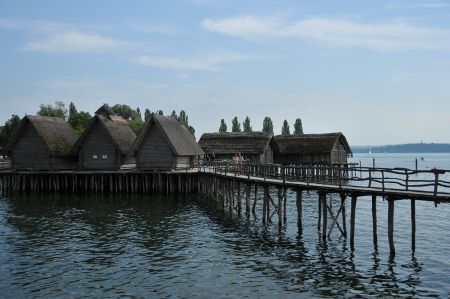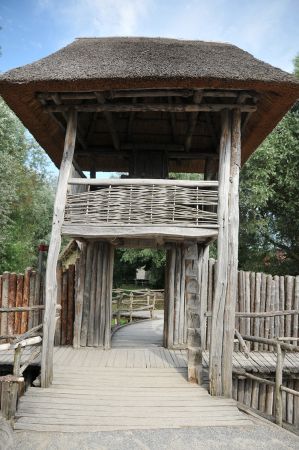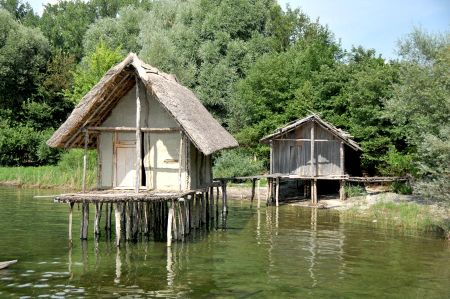A meeting in Zurich in the early morning made the trip to Switzerland necessary and Lydia and Johannes spontaneously wanted to take the opportunity to look around Konstanz a little.
We had travelled from Augsburg in the direction of Zurich several times and had learned to appreciate the ferry crossing across Lake Constance to Constance. Although the journey time is a bit longer due to the sometimes narrow and winding country roads with a lot of traffic, the landscape and nature make up for it in every case. The short ferry crossing also brings a little variety and relaxation as well as wonderful views of Lake Constance and the Alps in the background.
 From Konstanz it was only 80 kilometres to the appointment, which was quickly covered on the autobahn. Since the meeting also went smoothly, we were back in Konstanz after a good two and a half hours and thanks to the mobile phone connection we were able to meet Lydia and Johannes again without any problems. Only parking turned out to be a real problem if you only have to wait for someone for a short time. The two had looked at the aquarium and reported enthusiastically about the tunnel through the underwater world.
From Konstanz it was only 80 kilometres to the appointment, which was quickly covered on the autobahn. Since the meeting also went smoothly, we were back in Konstanz after a good two and a half hours and thanks to the mobile phone connection we were able to meet Lydia and Johannes again without any problems. Only parking turned out to be a real problem if you only have to wait for someone for a short time. The two had looked at the aquarium and reported enthusiastically about the tunnel through the underwater world.
We had already discussed in advance that we wanted to drive to the Pfahlbaumuseum in Unteruhldingen after the appointment in Zurich, so we went back to the ferry in the direction of Meersburg.
 Shortly before Unteruhldingen we took a short break for lunch, which we also used to ask our innkeeper how to proceed. Parking in the village is always a bit difficult, so we were offered a parking space right away and we walked the short distance to the Pfahlbaumuseum. Over the years, the many television reports are probably also partly responsible for the relatively high level of awareness of the pile dwelling museum, because after all, whole families spent some time here for the purpose of self-discovery, in order to understand the life of our ancestors. The museum itself can also refer to a long history of its own, because as early as 1922, the year it opened, the museum, which was small at the time, already had more than 6,000 visitors.
Shortly before Unteruhldingen we took a short break for lunch, which we also used to ask our innkeeper how to proceed. Parking in the village is always a bit difficult, so we were offered a parking space right away and we walked the short distance to the Pfahlbaumuseum. Over the years, the many television reports are probably also partly responsible for the relatively high level of awareness of the pile dwelling museum, because after all, whole families spent some time here for the purpose of self-discovery, in order to understand the life of our ancestors. The museum itself can also refer to a long history of its own, because as early as 1922, the year it opened, the museum, which was small at the time, already had more than 6,000 visitors.
The focus of the museum was and is the presentation of archaeological finds from the Stone and Bronze Ages in the replicas of former buildings of pile villages. Today, the museum can proudly refer to 23 of these pile replicas, but thanks to the affiliated scientific research institute, it is one of the recognized top addresses of our prehistory. With the recognition as a UNESCO World Heritage Site and inclusion in the list of elements worthy of protection in 2011, the remains of the numerous historical finds of the surrounding pile dwellings, including the pile village Unteruhldingen-Stollenwiese, about 500 meters from the museum, were particularly distinguished.
We enter the complex in Unteruhldingen through the modern museum building, where we are first led into a circular building that vividly documents the work of the archaeologists in a kind of 360° cinema. You almost feel one with the divers who are exploring the remains of the pile dwellings on the bottom of the lake. Now a part of the "cinema screen" opens and you enter the antique-looking ensemble of houses, which are connected to each other with bridges made of tree trunks and branches. It's easy to feel like you've been transported back in time, because the bridge constructions always swing a little with every step you take.
The boardwalk leads from house group to house group and we take our photos, receive additional information through film contributions and textual information. Everything is presented clearly, so that you can follow the different epochs of development of the settlers.
The Stone Age houses in Riedschachen
After a lecture by Hans Reinerth on the excavations of ancient pile dwellings on Lake Federsee during the 1920s, the then mayor Georg Sulger had the idea of building pile dwellings in Unteruhldingen on Lake Constance. The mayor received support in 1921 from the Überlingen city archivist Victor Mezger and also from the local office manager Hermann Levinger, so that the idea soon led to the establishment of the Verein für Pfahlbau- und Heimatkunde e.V. with the date of March 12, 1922. Shortly thereafter, under the guidance of the Prehistoric Research Institute in Tübingen, the first two stilt houses were built, making the Stone Age houses in Riedschachen the oldest reconstructions in the museum. In 1922, the shore area belonged to the property of the Deutsche Reichsbahn, which is why it was not possible to reconstruct the Neolithic settlement of Riedschachen near Bad Schussenried directly on the shore. Mayor Sulger then decided to build on piles in the bank area.
The Neolithic moor village around 4000 BC. Chr. was archaeologically examined only shortly before. The reconstruction was a collaboration between the Unteruhldingen Association for Pile Dwelling and Local History and the Prehistoric Research Institute in Tübingen.
With the construction of the Stone Age village of Sipplingen am Ufer in 1938, the two houses were to be demolished. However, the outbreak of World War II prevented this.
♁47° 43′ 33″ N, 9° 13′ 39″ E
The Bronze Age village of Bad Buchau
The platform-supported village of the Late Bronze Age settlement of Bad Buchau are idealized reconstructions from the period between 1923 and 1931, which were designed on the basis of the excavations of the Buchau moated castle (circa 1050 BC) on the Federsee and under the direction of Hans Reinerth. They no longer represent the current state of research, which now sees the Wasserburg Buchau (the factual wrong name was coined by Reinerth in 1928) as a wet soil settlement and not as a pile dwelling settlement.
Today the platform includes three log houses and two houses with wattle and daub walls. The houses are entirely thatched. The idea of the continuous platform reflects the doctrine of pile-dwelling settlements that prevailed in Central Europe in the 19th century. It shows the bronze caster's house with a free-standing furnace, the village elder's house, the potter's house with a free-standing pottery furnace, a shepherd's house and a storehouse.
On Holy Saturday 1976 a fire destroyed the Bronze Age pile-dwelling village 1. It was only possible to reopen the following year.
♁47° 43′ 34″ N, 9° 13′ 40″ E
The Stone Age village of Sipplingen
The Stone Age village of Sipplingen is a lakeside settlement consisting of six stilt houses with a surrounding palisade. It was built between 1938 and 1940 based on the excavations near Sipplingen on Lake Constance, a Neolithic village (around 3500 BC). With this reconstruction, the theory of the bank pile dwellings was implemented true to scale for the first time.
Coming from the shore, you enter it through a weir system. The reconstruction shows the house of the fisherman and the potter. Next is the weaver's house, the house of the stone mason and the house of the wood carver. The centre of the Stone Age village is the village hall.
♁47° 43′ 36″ N, 9° 13′ 43″ E
Hornstaad House and Arbon House
Both houses from 1996 and 1998 are reconstructions of Stone Age houses that were built for research reasons.
The Hornstaad house has its historical origins in a Stone Age settlement (around 3912 BC) with around 40 houses in Hornstaad-Hörnle on the banks of the Hörispitze, which was destroyed by fire and from the Baden-Württemberg State Monuments Office from 1980/1983 to 1993 was excavated. The construction was a research effort of three to four people who spent about two months building this house made of wood, grass and mud. The research work was primarily aimed at questions relating to the resilience and durability of such a building. A subsequent occupation of the house by a museum employee was part of the experiment. The employee, called "Uhldi" by visitors, developed into a magnet for visitors and has since lived in the house periodically. The field reports are published in the club magazine Platform.
The Arbon house was built according to the results of excavations in the Stone Age settlement of Arbon-Bleiche III in the canton of Thurgau (Switzerland). The house was originally built in 3376 BC. and 3370 B.C. destroyed by fire. According to archaeological findings, the reconstruction has a shingle roof made of silver fir boards up to two meters long, which distinguishes it from the other houses in the museum, which are covered with reeds and grass.
♁47° 43′ 34″ N, 9° 13′ 44″ E
The Bronze Age village of Unteruhldingen
The Bronze Age village of Unteruhldingen-Stollenwiesen consists of five buildings and a palisade section, which, in terms of museum education, takes up the themes of housing and handicrafts, the environment and animals, as well as cult and religion. They were built between 1999 and 2002 as part of a European project. An attempt was made to create an image of a Bronze Age village from around 3000 years ago with originally around 80 houses on an area of 400 square meters. 27 figures with their prehistoric equipment are evidence of active trade relations to the salt and copper mines of the Alps and further to Italy. Cult and religion are shown in the so-called cult house, a house furnished with wooden figures of gods, with a priestly incantation on the hearse of a wealthy person.
♁47° 43′ 36″ N, 9° 13′ 39″ E
SWR Stone Age Village
For the 2007 season, the previous houses were expanded to include the original houses from the TV series "Steinzeit - Das Experiment". Extended life as it was 5000 years ago. The production of the Südwestrundfunk in co-production with the Bayerischer Rundfunk and in cooperation with the Pfahlbaumuseum Unteruhldingen, the Schleswig State Museum, the Albert-Ludwigs-University Freiburg and the University Hospital Freiburg, in the summer of 2006 put 13 people back into the life of a clan of the Neolithic. The film set, a small pile-dwelling village reconstructed true to the original, was built in the "Himmelreichmoos" in Erbisreute-Fuchsenloch near Schlier (Ravensburg district) especially for this purpose and then brought to Uhldingen. There, the three Stone Age houses on the shore were rebuilt. The establishment of a pile dwelling Stone Age workshop is planned here.
♁47° 43′ 35″ N, 9° 13′ 45″ E
After our tour we find hundreds of archaeological pound pieces from the earlier excavations of Unteruhldingen and Sipplingen well prepared in the so-called "Old Museum". With the "New Museum", exhibition, storage and research rooms were also made possible, which were designed to be handicapped accessible. The exhibition presents excavation finds, true-to-scale models of the pile dwelling period, pictures of pile dwellings from all over the world and research history.
As early as 1927/28, UFA had produced the film "Nature and Love", which impressively depicts the life of Stone Age people against the backdrop of the pile dwellings. There is also a wide range of information on this, as well as on the documentation of the various broadcasters, through which we also became aware of the stake village.
Please read as well:
Museum Complex Museum on Water at Lake Ohrid
The natural philosopher Democritus from Abdera
From Meersburg to Constance via Lake Constance


